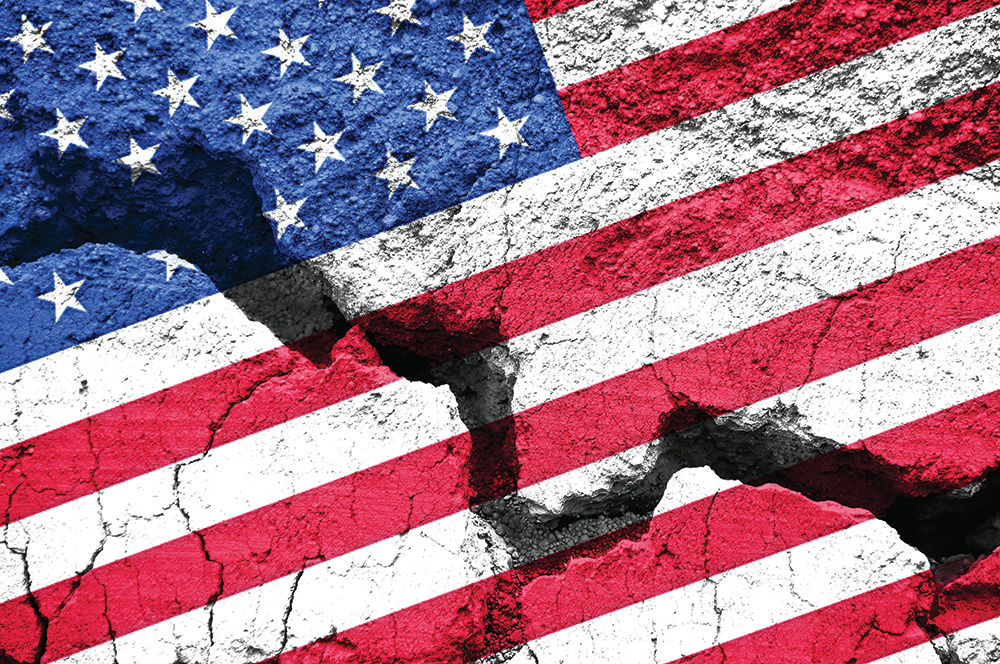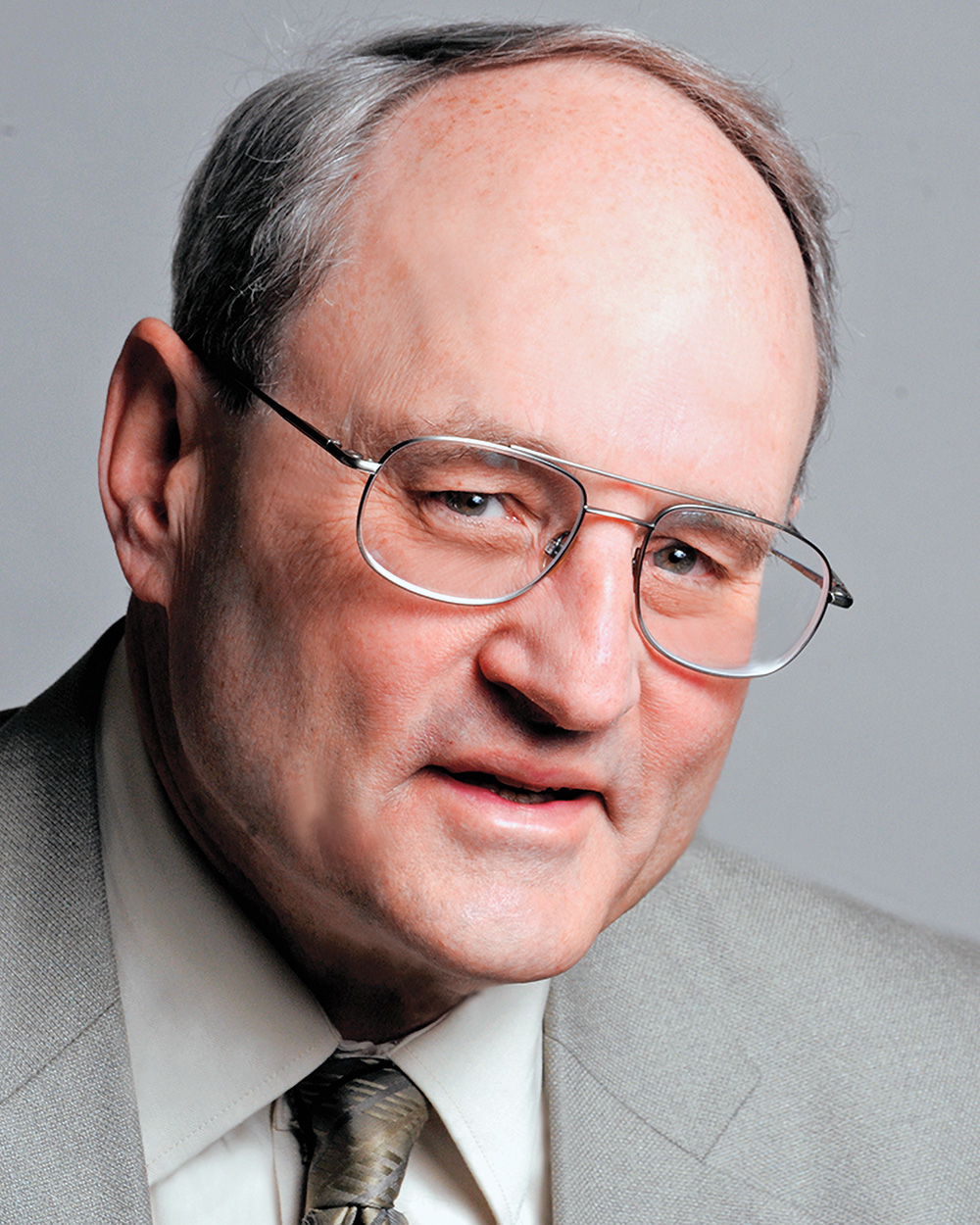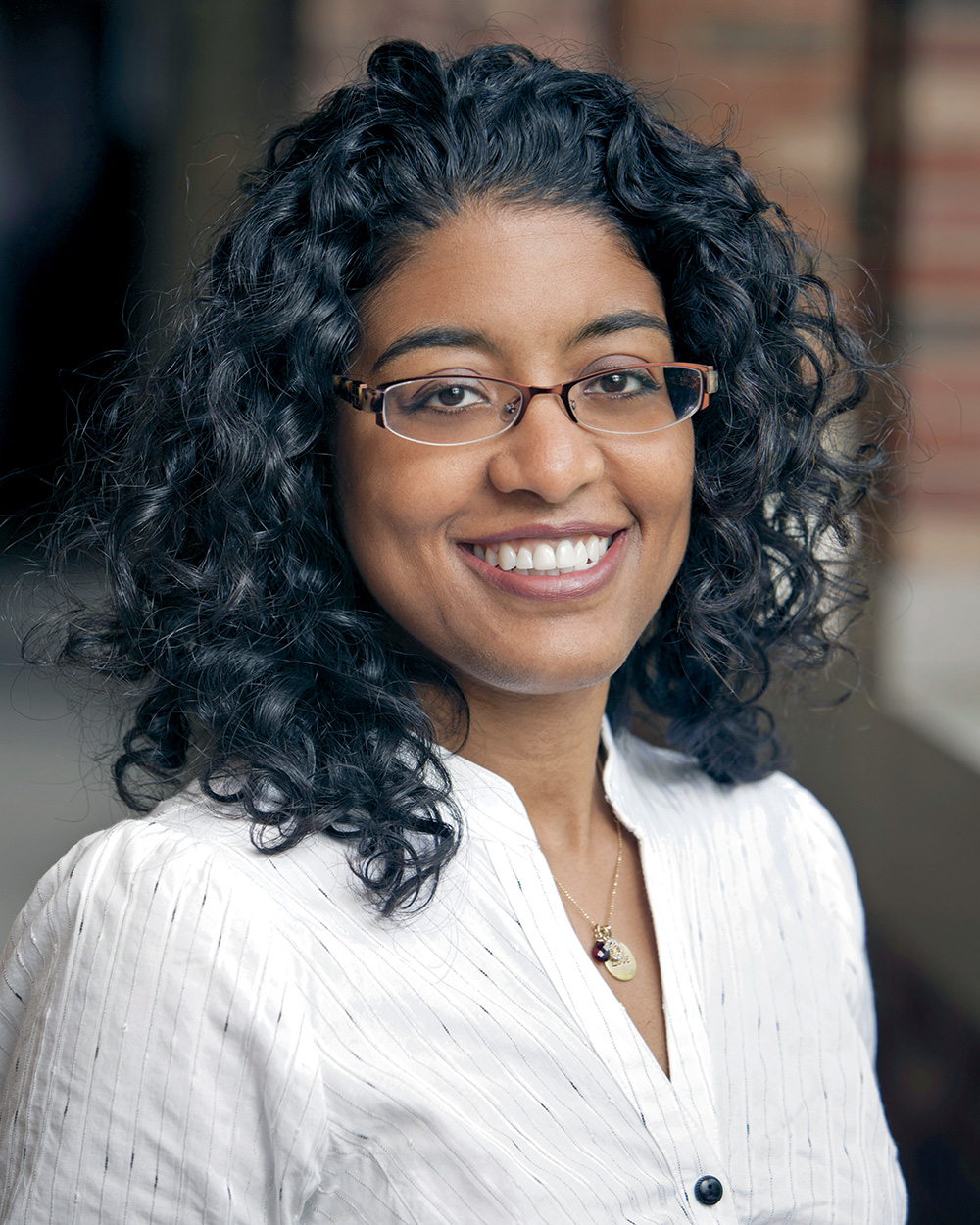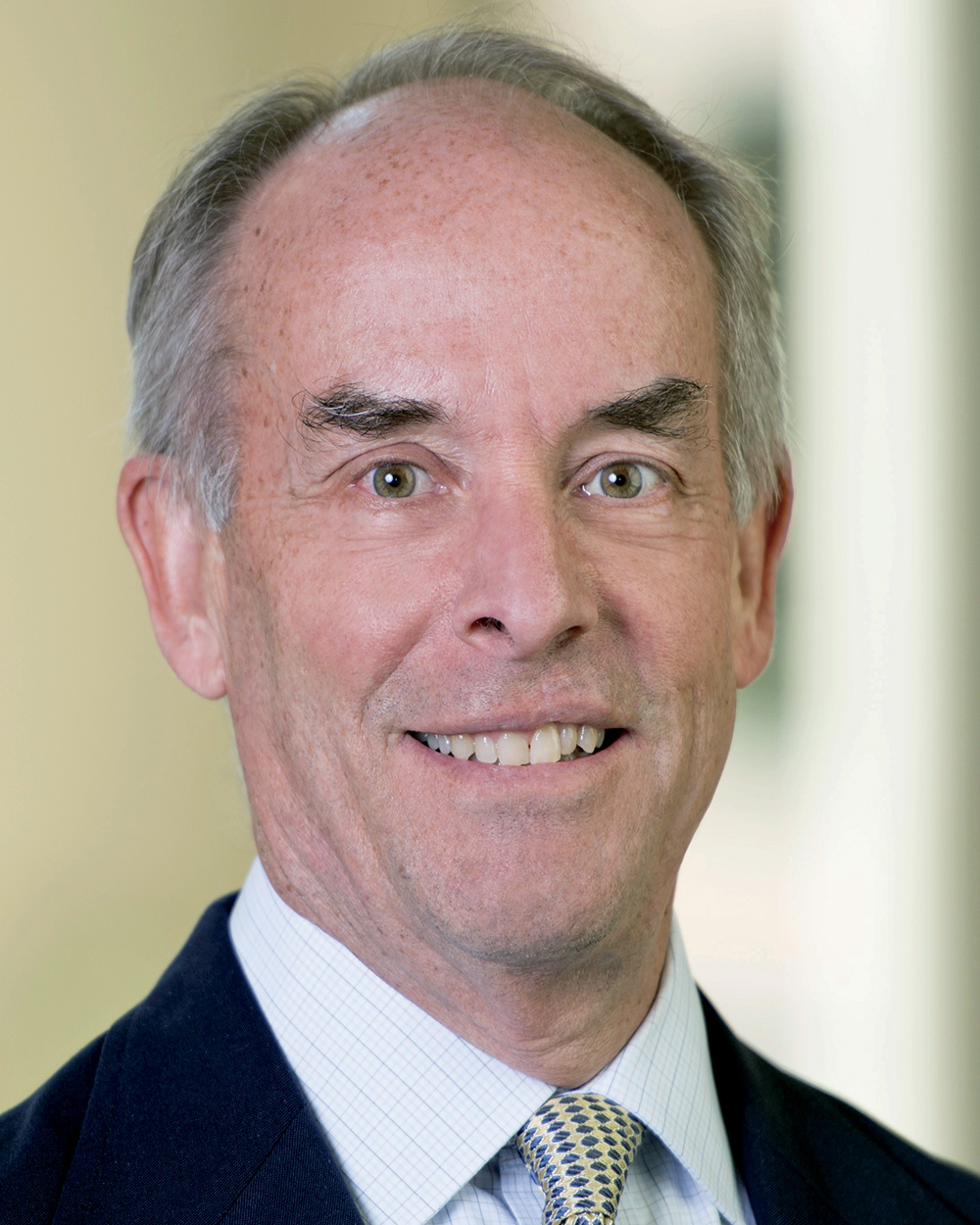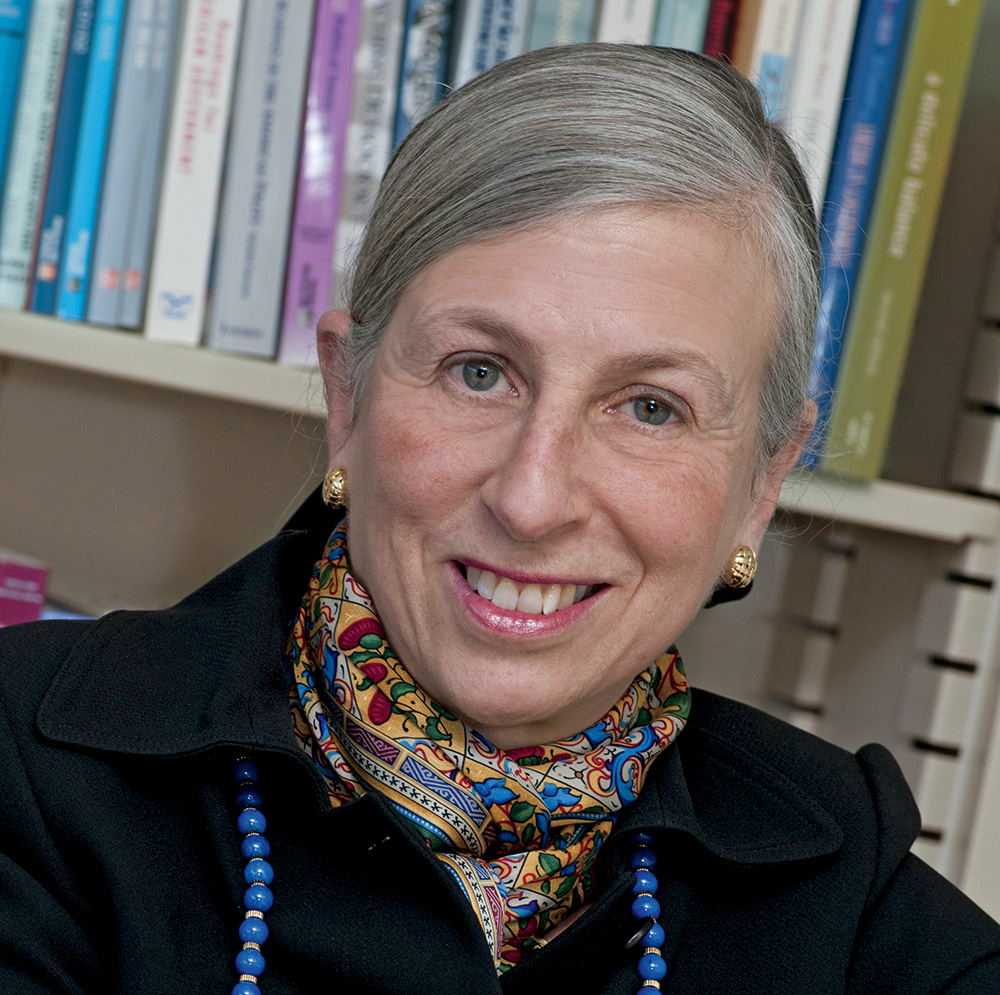2110th Stated Meeting | January 18, 2023 | Virtual Event | Morton L. Mandel Conversation
What happens when Americans lose trust in institutions once thought of as nonpolitical – like election administration, the police, medicine, science, the media, and law? What does the hardening connection between distrust and political polarization mean for the functioning of society? The Fall 2022 issue of Dædalus, made possible in part by a generous gift from the John S. and James L. Knight Foundation, explores institutions, experts, and the loss of trust.
On January 18, 2023, the Academy hosted a virtual discussion with the guest editors of the Dædalus volume, Henry E. Brady and Kay Lehman Schlozman, and authors Tracey L. Meares and Lee Rainie to examine the causes and consequences of the loss of confidence in institutions and the people who lead them. Academy President David W. Oxtoby offered introductory remarks. An edited version of the presentations and discussion follows.
David W. Oxtoby
David W. Oxtoby is President of the American Academy of Arts and Sciences. He was elected to the Academy in 2012.
Good afternoon and welcome to this important conversation on trust in institutions. As is Academy tradition, it is my pleasure to formally call to order the 2110th Stated Meeting of the American Academy of Arts and Sciences. Today’s event has the distinction of being a Morton L. Mandel Conversation. Our late friend, Mort Mandel, had a keen appreciation for the power of dialogue and the necessity of robust public institutions. His generosity enables us to be here today to address distrust, polarization, and institutional efficacy – topics central to the Jack, Joseph, and Morton Mandel Foundation’s mission. We are grateful for their continued support.
Our conversation today will center around ideas advanced in the most recent issue of Dædalus, the quarterly journal of the American Academy. Dædalus was first published in 1955 and has tackled a prodigious breadth of topics over the past sixty-eight years – everything from climate change, to artificial intelligence, to American music and jazz. Every issue of Dædalus, no matter the focus, is distinguished by its rigor, authority, and contribution of new knowledge. In January 2021, the Academy and our publishing partner, The MIT Press, announced that the journal would be moving to open access. In the two years since, Dædalus has seen a significant increase in online readership, downloaded essays, and citations. We are proud of this investment in making Dædalus content – both past and future – available to as wide an audience as possible. It is our belief that increasing access to knowledge can play a constructive role in increasing public trust in information and in institutions themselves.
Repairing the erosion of trust in institutions is an essential task that stretches across all Academy endeavors. From the work of our Commission on the Practice of Democratic Citizenship, to recent projects on Public Trust in Vaccines and The Public Face of Science, to our ongoing Commission on Accelerating Climate Action and now this most recent issue of Dædalus, addressing the polarization of trust has been a major Academy priority and will remain so going forward.
The Fall 2022 issue of Dædalus on “Institutions, Experts, and the Loss of Trust” was made possible, in part, by a generous gift from the John S. and James L. Knight Foundation. We are grateful to Knight Foundation President and Academy member Alberto Ibargüen for his support of this volume and his many contributions to the work of the Academy. We are also grateful to our guest editors, Henry E. Brady, the Class of 1941 Monroe Deutsch Professor of Political Science and Public Policy at the University of California, Berkeley, and Kay Lehman Schlozman, the J. Joseph Moakley Endowed Professor of Political Science at Boston College, for their leadership and vision on the volume. We are proud to count Henry and Kay as members of the American Academy.
Henry and Kay are joined today by two contributors to the volume: Tracey Meares is the Walton Hale Hamilton Professor and Founding Director of the Justice Collaboratory at Yale Law School and author of the Dædalus essay, “Trust and Models of Policing.” She was elected to the Academy in 2019. Lee Rainie is Director of Internet and Technology Research at the Pew Research Center and contributed the essay “Networked Trust and the Future of Media.” We are grateful to Tracey and Lee for joining us today. Following their brief presentations, Kay will moderate a conversation among the panelists. It is now my pleasure to turn things over to our coeditor, Henry Brady.
Henry E. Brady
Henry E. Brady, a Fellow of the American Academy since 2003, is the Class of 1941 Monroe Deutsch Professor of Political Science and Public Policy at the University of California, Berkeley. He served as Dean of the Goldman School of Public Policy from 2009 to 2021.
Our discussion today is about distrust and polarization in America’s institutions. You may ask, why does it matter? Why do we care about whether people trust major institutions? Well, confidence and trust are essential to legitimacy and to the ability of institutions to operate effectively. Without legitimacy, people won’t trust these institutions, and as a result, they may not be willing to go along with the solutions these institutions put forth to solve the problems that we face.
We know that confidence in governing institutions has fallen and that it is politically polarized. That is not a surprise. Government is about different perspectives, so one might expect that confidence in governing institutions would be polarized based upon one’s political perspective. But what about nonpolitical institutions, such as business, churches, the police, the military, K–12 schools, television, and the press? What has happened over the last fifty years with respect to trust in these nonpolitical institutions?
In my Dædalus essay with coauthor Thomas Kent, a graduate student at the University of California, Berkeley, we start with a large data set that we compiled. It is based upon melding three data sets: Harris Polls from 1967, General Social Surveys from 1972, and Gallup Polls from 1973. The questions asked in each of these polls or surveys about trust or confidence are slightly different, and so we worked hard to make sure that we could make the data as comparable as possible. In the end, we have 165,000 respondents, 128 surveys from 1972–2021, and a four-point scale for trust that goes from 0 (hardly any confidence) to 3 (a great deal of confidence).
Figure 1 shows confidence in governmental institutions over time. What we see is that the confidence in our governmental institutions has gone down over time. For the Supreme Court, it has gone down a bit; the presidency, a bit more; the executive branch, even more; and Congress, most of all. Confidence in Congress is exceptionally low.
These figures use Henry Brady and Thomas Kent’s data and calculations from pooled Gallup Polls, Harris Polls, and General Social Surveys.
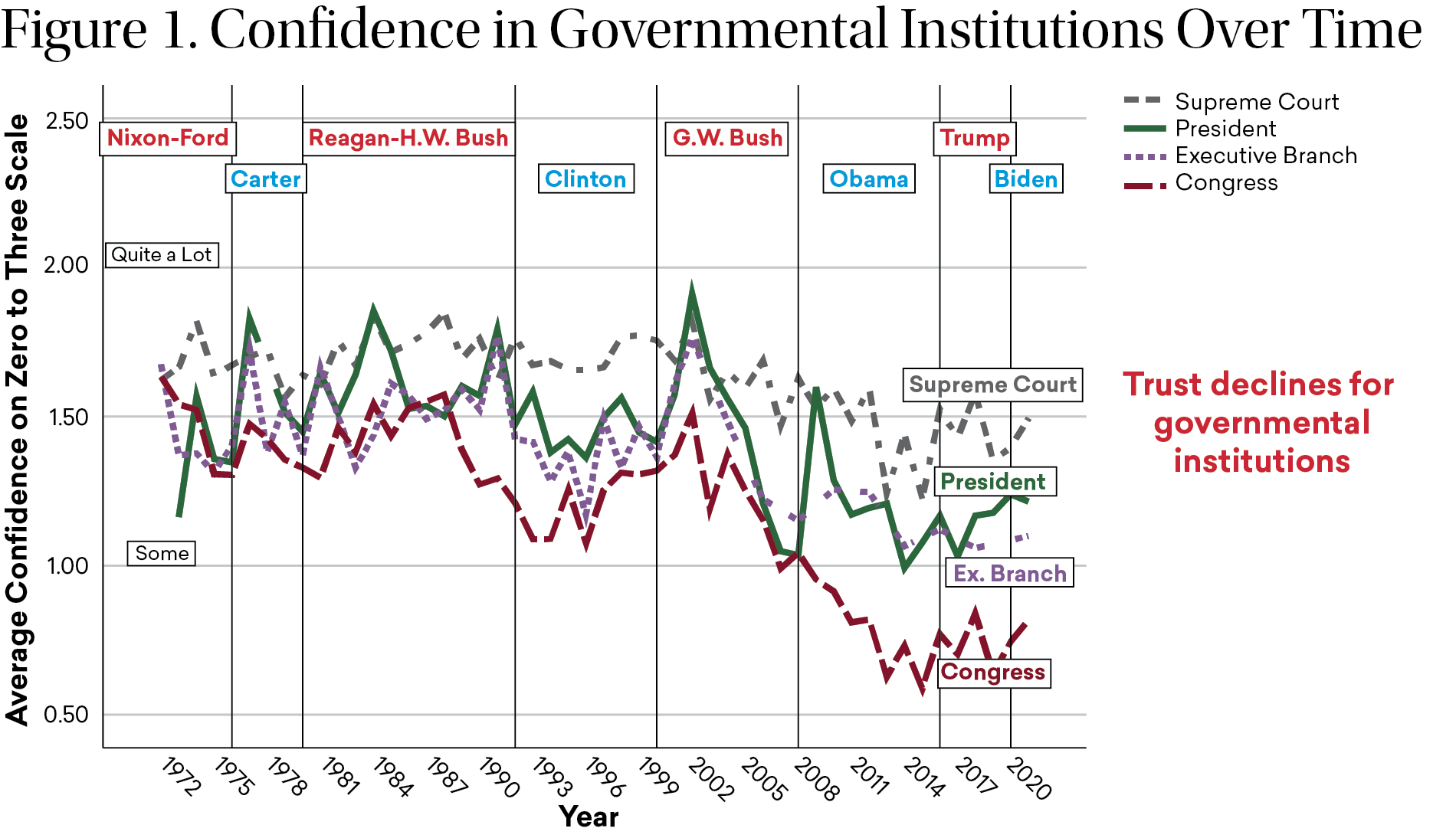
If we look at confidence in two nonpolitical institutions – police and the press – from 1973 to the present (see Figure 2; unfortunately, we have some interruptions in the data series for police), we see that confidence in police has declined a bit, and confidence in the press has declined precipitously.
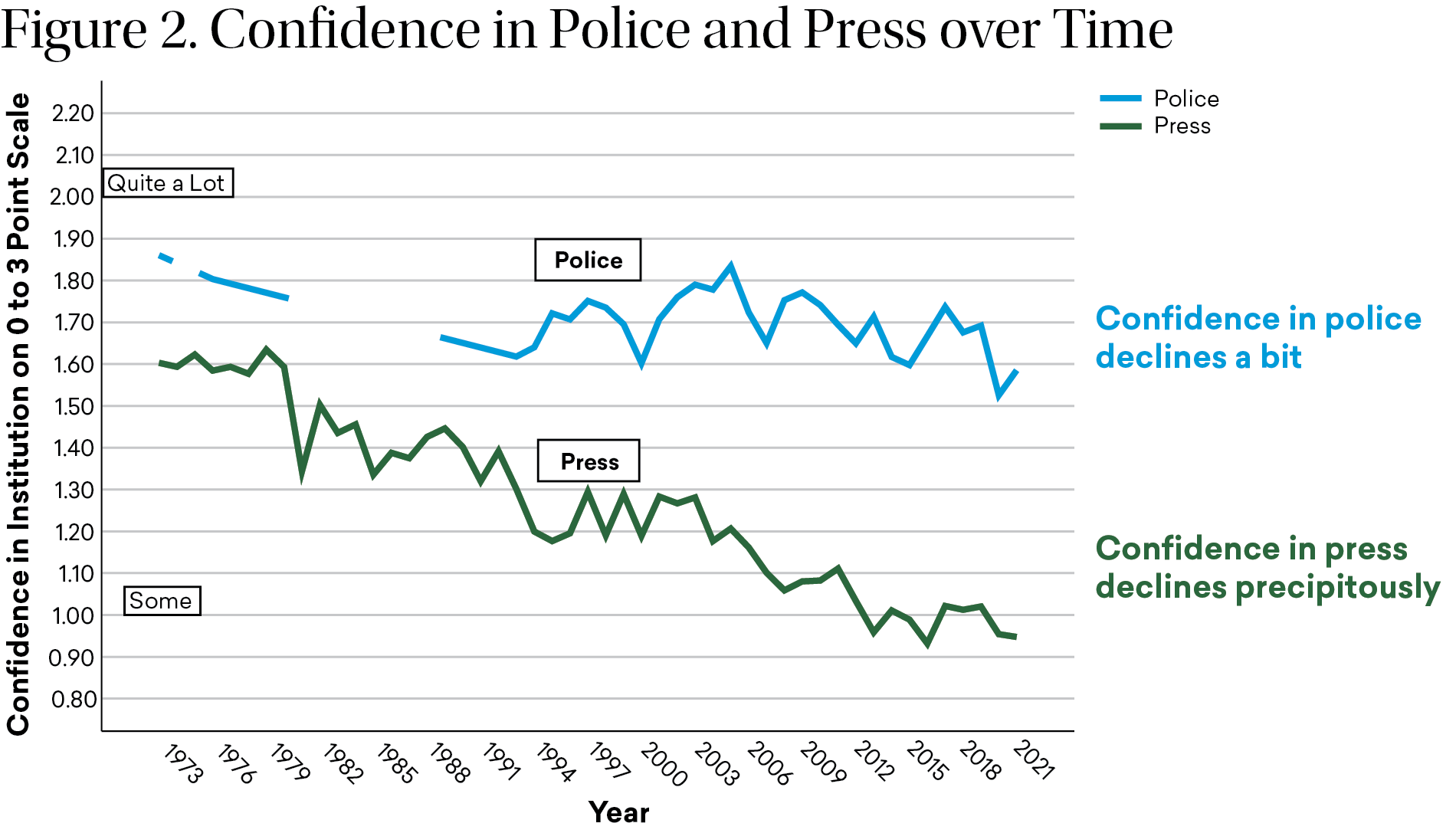
And if we look at the twenty institutions in our data (see Figure 3), we find that the four governmental institutions that we looked at previously – represented by the darker bars – have had varying levels of declines in confidence, but the nonpolitical institutions have also had significant declines in trust, ranging from Wall Street and TV news at one side to labor and science on the other. And what is interesting is that trust in the military has increased. We also see that the press and police span the gamut of declines in trust over the last fifty years.
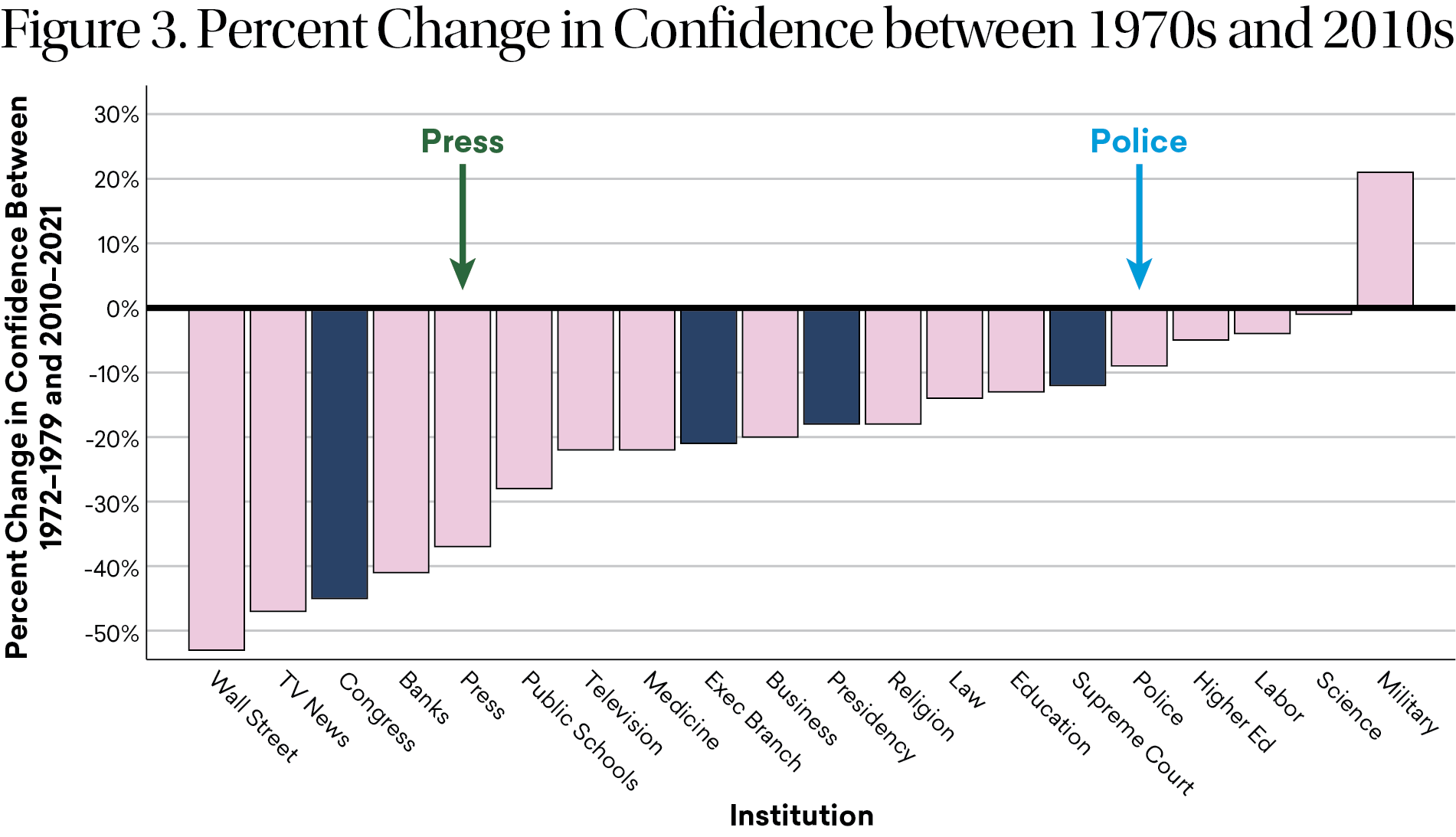
Let’s now turn to partisan confidence in the presidency over time. What we find is that when there is a Republican president, Republicans are more trusting, and when there is a Democratic president, Democrats are more trusting. That’s not a big surprise. What we also find, however, is that there is a real difference between Democrats and Republicans over time in how much they trust or distrust the presidency. The top bar going across in Figure 4 shows that for the peaks, which represent the views of the partisans of the party of the incumbent president, their sense of trust in the presidency hasn’t changed much over time. Republicans trust Republican presidents and Democrats trust Democratic presidents. Partisans of the current president have about as much trust today as they did fifty years ago. However, for those who are not partisans of the president – the out-group, if you will – their confidence in the presidency has declined substantially over time (shown in the bottom bar that declines downward).
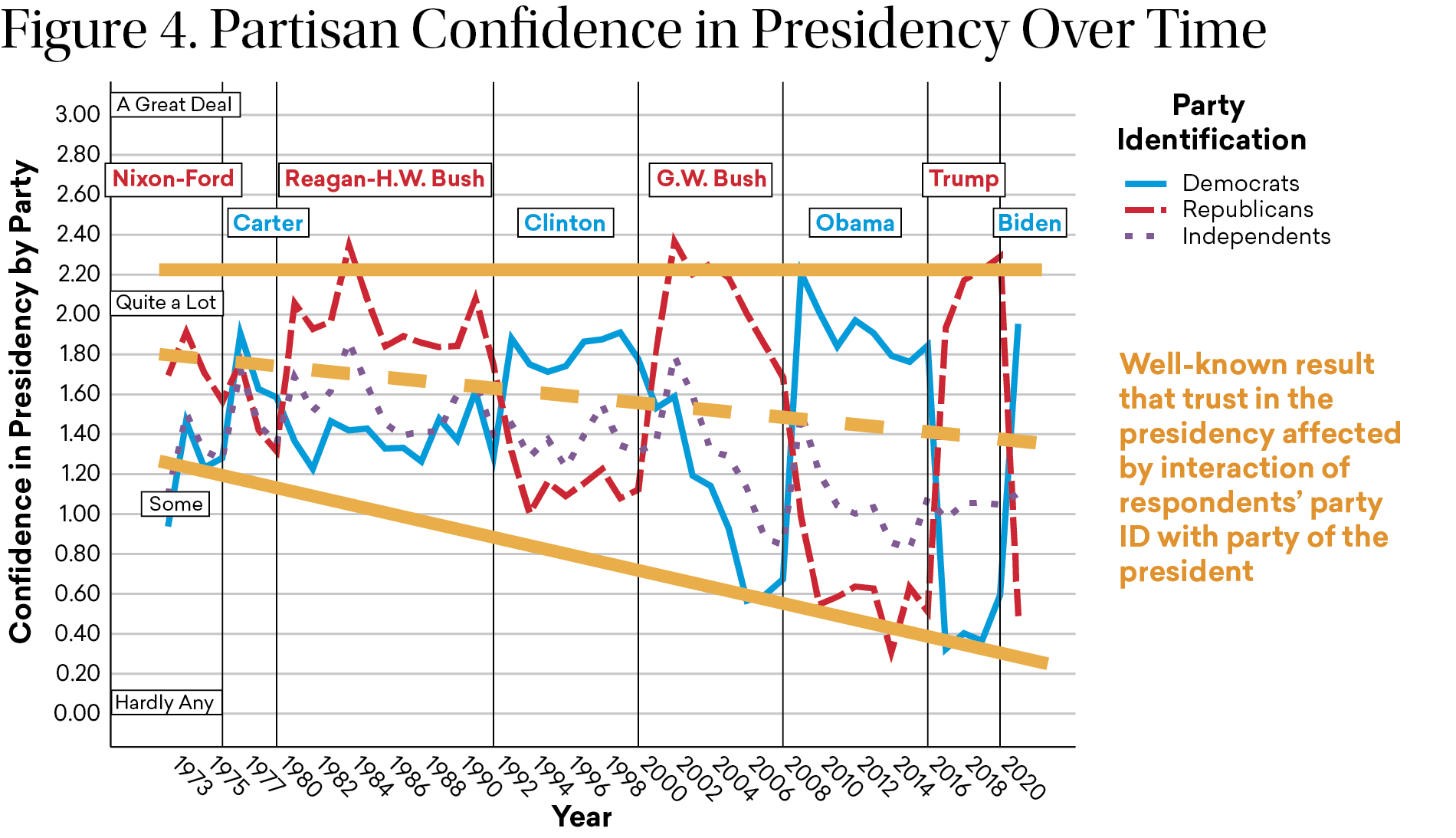
It is not surprising to see partisan differences in confidence in political institutions, but it is a bit unexpected to see it in nonpolitical institutions. If we look at partisan confidence in the police over time, we find that for Republicans (represented in the top line in Figure 5), their trust in the police has gone up somewhat, but for Democrats, their confidence has dropped significantly over time. The Democratic Party includes many African American voters, and their trust with respect to the police has been especially low. Tracey will talk about that and why that is so in her presentation.
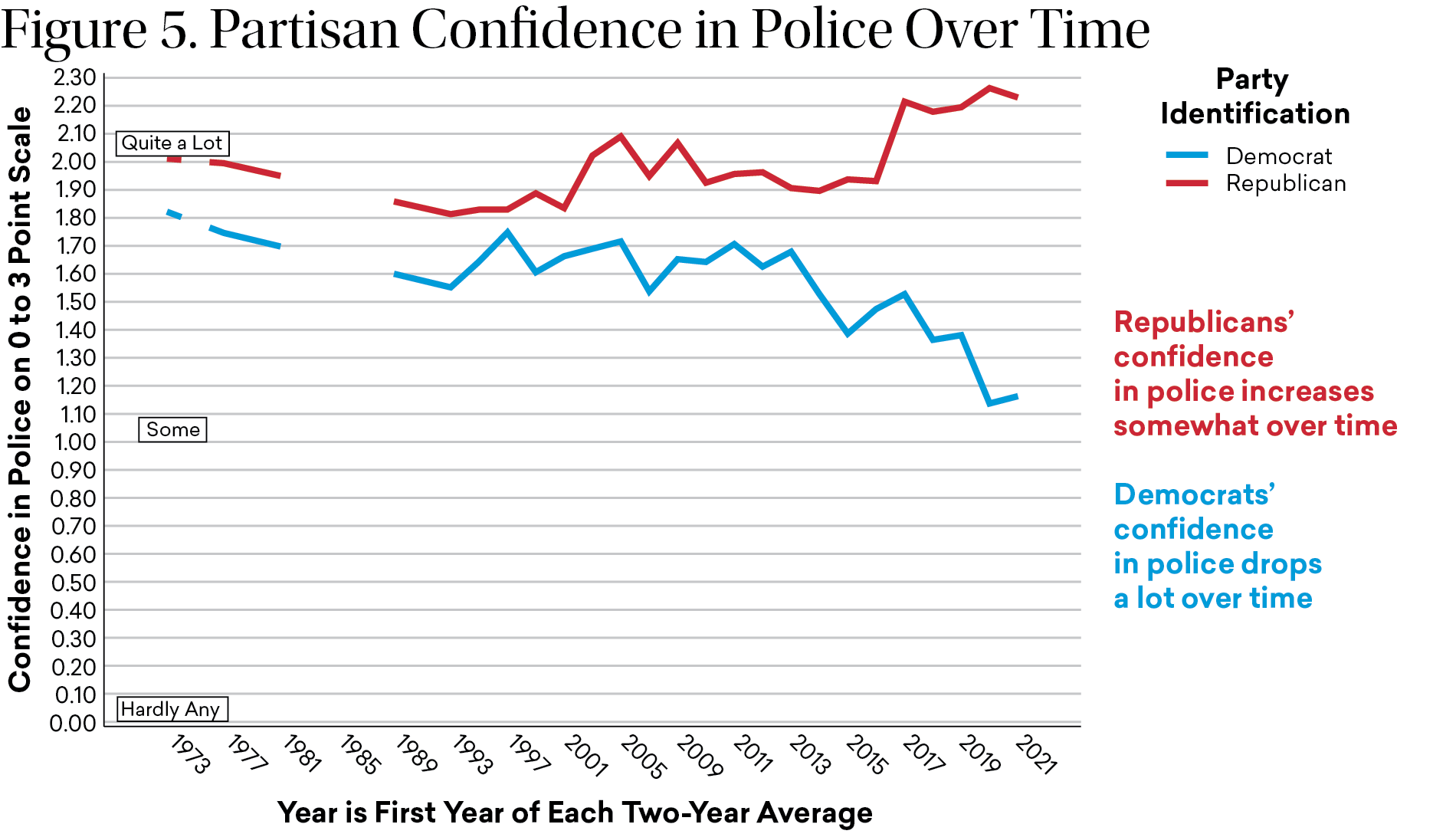
What about the press? As we see in Figure 6, Democrats’ confidence in the press stays high over time, but Republicans’ confidence has dropped, and rather precipitously.
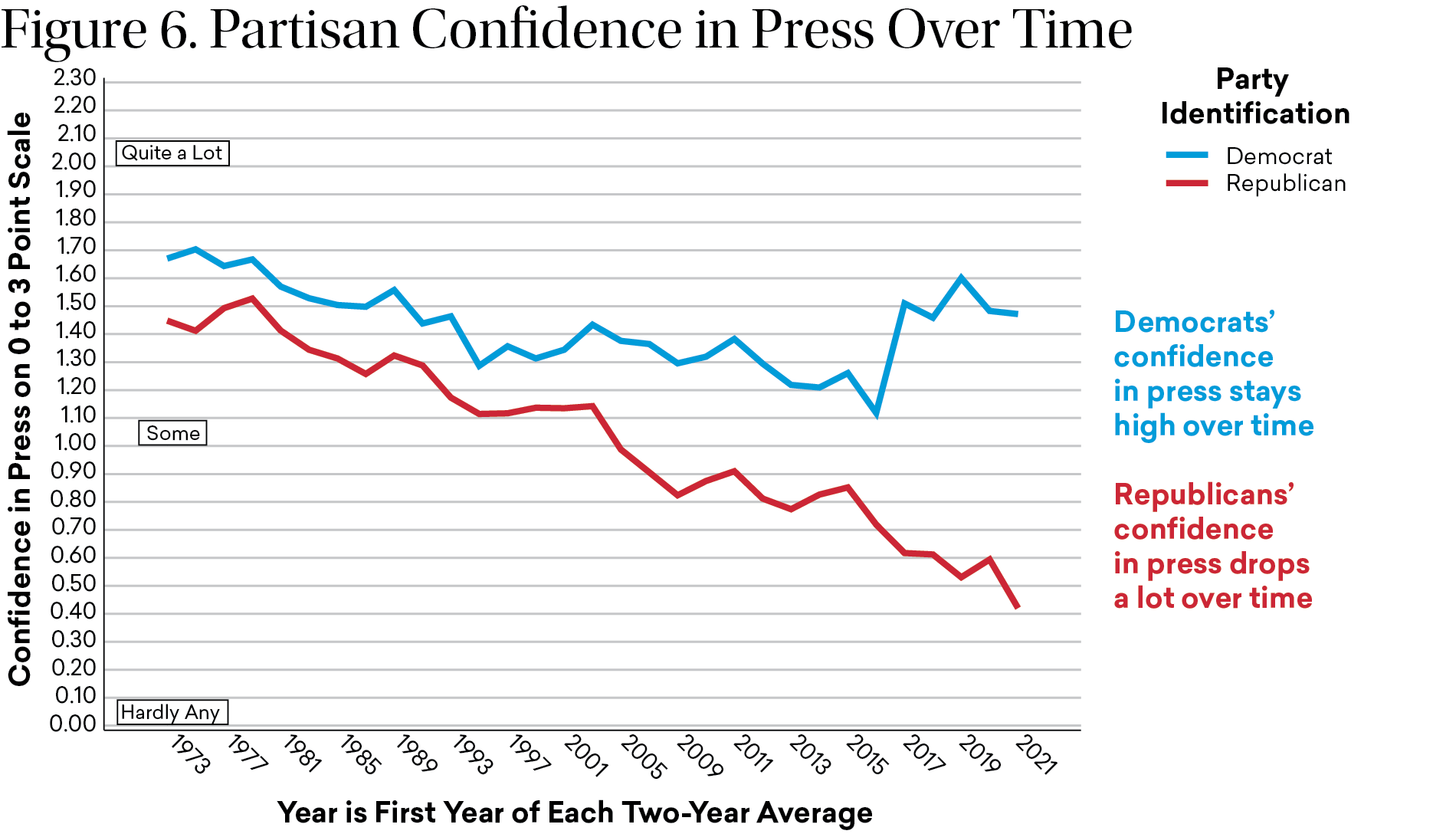
Let’s look at how much change there has been in polarization over time across all institutions. In Figure 7, we have plotted the confidence of Democrats in various institutions in the 1970s versus the confidence of Republicans in those institutions in that same time period. If the partisans of the two parties agreed on their confidence in a particular institution, the point for that institution on the graph would fall along the solid line, which is at about 45 degrees in the middle of the picture. However, if they disagree, we see that reflected in data points above or below that solid line. For instance, the Democrats trusted labor more than the Republicans did in the 1970s, and the Republicans trusted business more than the Democrats did. We also see that there is not that much of a difference between Democrats and Republicans in terms of trust in most of these institutions in the 1970s, except, however, for business and labor.
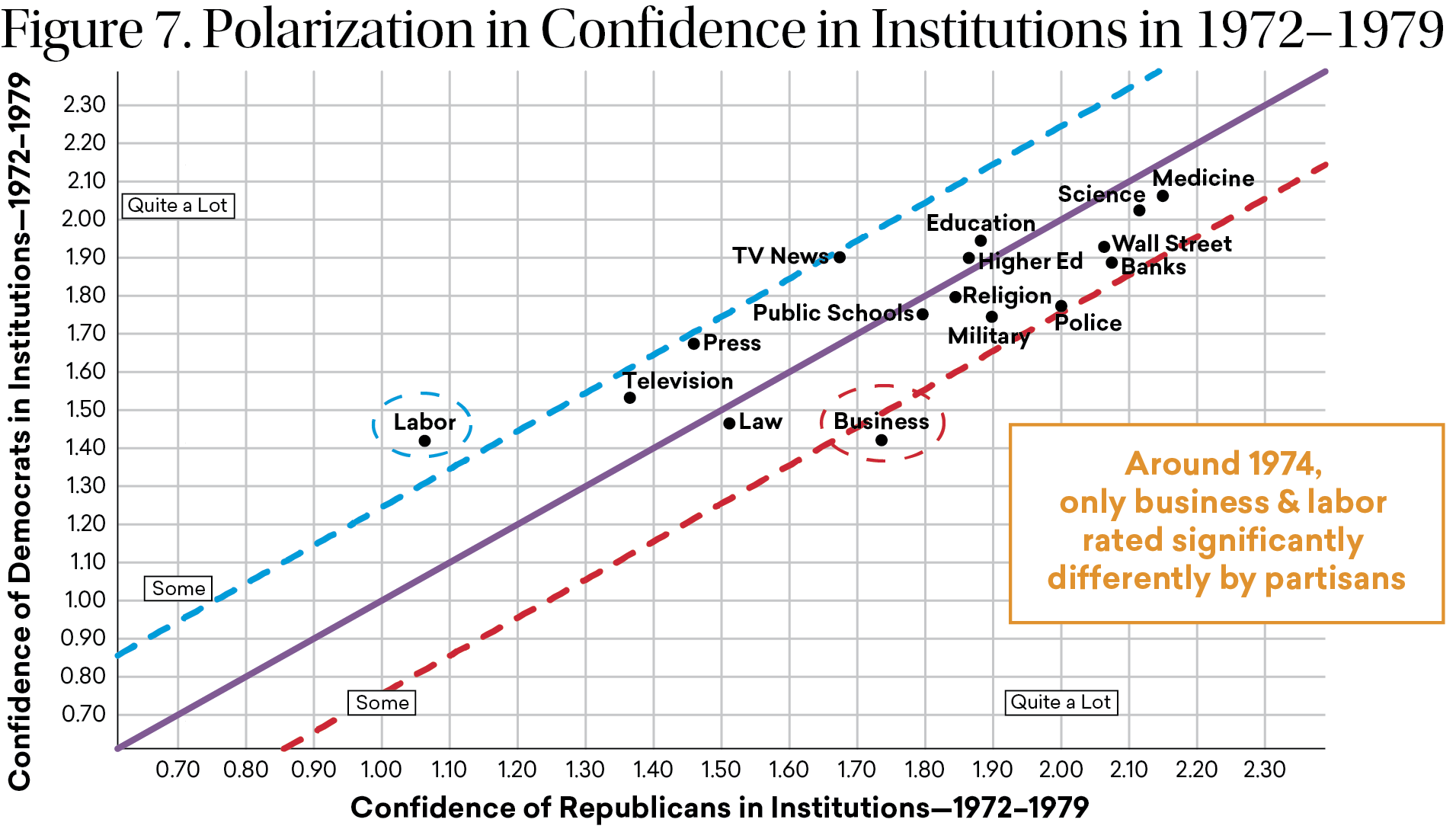
Now, let’s look at what happened in the 2010s (see Figure 8). Everything explodes outwards. What we find is that on the Democratic and Republican sides, polarization in confidence has increased for almost every institution. For the Democrats, confidence is higher than for the Republicans in what we might call the knowledge-producing institutions: the press, TV news, public schools, higher education, and science. For the Republicans, confidence is higher than for the Democrats in the norm-enforcing and order-preserving institutions: religion, police, and the military. It is quite an extraordinary change in who trusts which institution.
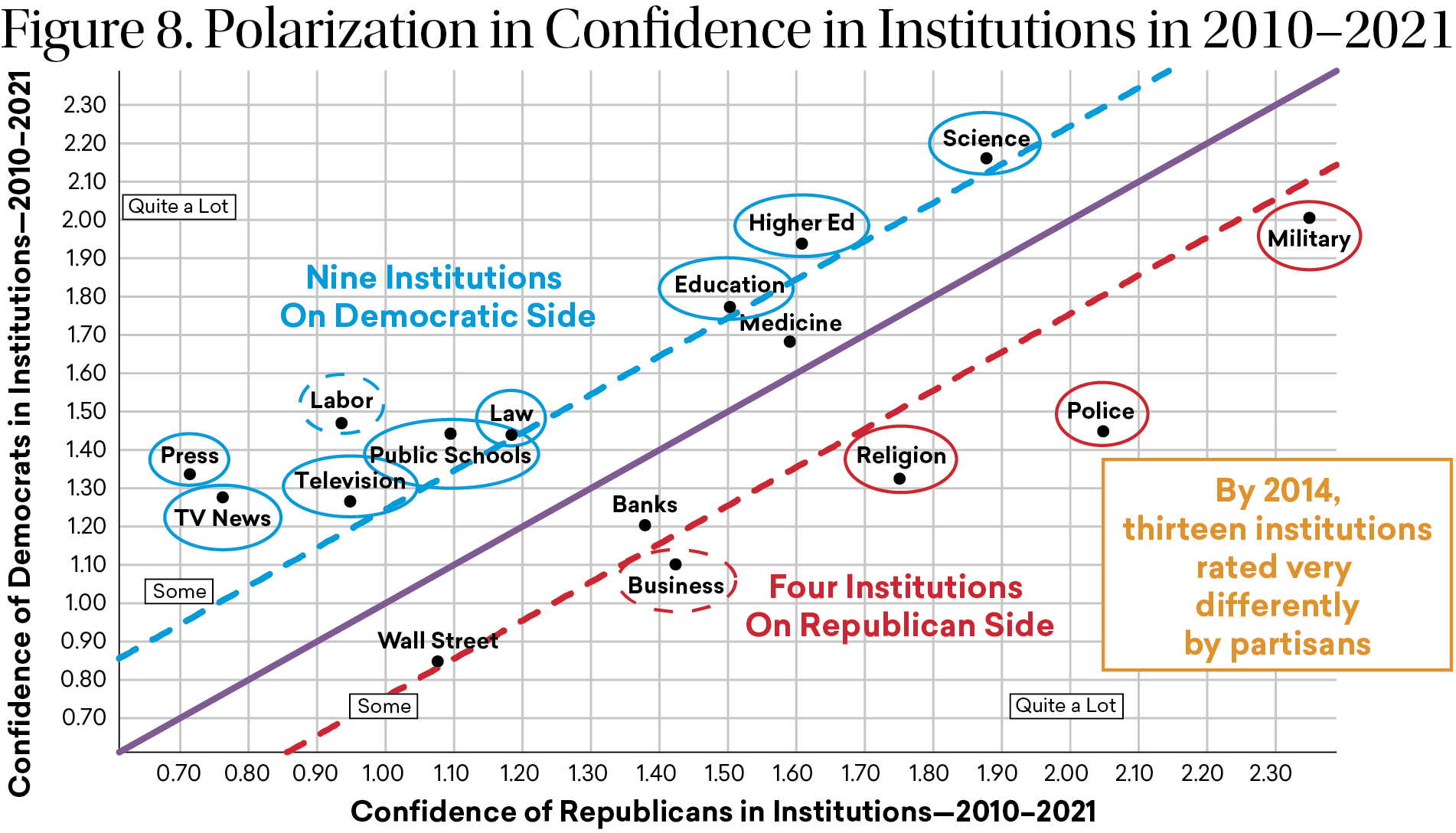
So, what have we found? Confidence in governing institutions has declined since the 1970s, and confidence in these institutions is now more polarized. Trust in nonpolitical institutions has declined since the 1970s, except for the military. Confidence in nonpolitical institutions used to be politically polarized between just labor and business, but now confidence is polarized in almost all nonpolitical institutions, with Republicans more confident in business, the military, police, and religion, and Democrats more confident in labor, the press, television, public schools, higher education, law, and science.
Why is this so? Perhaps one-third of the decline in trust is due to specific events. There is no question that bank failures caused banks to be less popular. Police behavior has an impact on the popularity of the police and confidence people have in it. Changes in press coverage impact confidence in the press. Perhaps another one-third of the decline in trust is due to a generalized distrust in institutions, fueled by Watergate and other events. Independents, not just Democrats and Republicans, have decreased their confidence in institutions. And for these Independents the explanation cannot be partisan polarization; it has to be something else. The final one-third or more of the decline is due to increasing polarization along political issue dimensions other than economic policy that separated business and labor in the past.
One speculation is that the rise of social, cultural, and racial issues as central features of our politics since the 1970s has also affected our beliefs about institutions. In addition, my colleague Thomas Kent has shown that the campaign contributions of people associated with a specific institution (for example, those who mention higher education or policing as their occupation) go consistently to more ideologically extreme candidates than in the past. For instance, those associated with higher education, the press, and science give to more ideologically liberal candidates than in the past, and those associated with the military and the police give to more ideologically conservative candidates than in the past. This result suggests that those working in these institutions are more ideologically homogenous and extreme than in the past. As a result, it is not surprising that there is partisan distrust of these institutions by the members of the party who do not feel represented by them.
What does this mean? On a 2019 survey, we asked respondents how they would feel about someone close to them choosing a career or marrying someone involved with various institutions. We were shocked and surprised to find that Republicans do not want their kin or friends to have a close association with journalists or with anyone working in higher education. Democrats do not want close connections with anyone in the police, the military, or religious institutions. Recent events suggest that distrusted institutions – such as police and public health – cannot be effective, and polarized trust leads to vastly different views on institutional performance and how we should reform institutions if we feel we need to do that. Given our partisan differences in how we evaluate institutions, it is hard to know how they can continue to be effective when a crisis occurs.
Tracey L. Meares
Tracey L. Meares, a Fellow of the American Academy since 2019, is the Walton Hale Hamilton Professor and a Founding Director of the Justice Collaboratory at Yale Law School.
My essay in the Dædalus issue explores the concept of trust and policing. From the 1990s to the early 2000s, violent crime rates plummeted in the United States. And the secular trend continued downward for another decade, although the decline was not as steep. New York City became one of the safest big cities in the world, when measured by homicides per capita. It was during this period that police dedicated themselves to a program of proactive policing designed, by its own terms, to attack violent crime. Think stop and frisk. This approach led some scholars to hypothesize about the relative importance of police activity as a contributing factor to the decline in violent crime.
I won’t explore that hypothesis here, although I have written about it. I would rather explore the following puzzle: police understood themselves as warriors against crime, and they had a plausible story to tell about their effectiveness at that task. One might think, too, that public confidence in police and policing would be related to police effectiveness at completing this task. But long-term polls, such as Gallup, tell a different story. Gallup has tracked public confidence in a random sample of adults over a range of institutions, including police, for just over a quarter of a century. And during that time, confidence among Americans in the police has remained largely flat, acknowledging the point that Henry made that there has been a slight decline. But we can say that even when the numbers are disaggregated, there has not been much change in the level of flatness. Among white respondents, the levels of those claiming to have a great deal or quite a lot of confidence in police range between 56 and 60 percent between 1993 and 2020. Among Black respondents, the confidence levels are lower – about half the level for whites, with the lowest rate of 19 percent in 2020. Except for 2020, the numbers for Black respondents are still relatively flat. The point here is that there seems to be very little relationship between police effectiveness at addressing violent crime, or at least the perception of it, and confidence in the institution.
So how might we explain this disjunction? The work I have done for the last fifteen years focuses on the relationship between process-based fairness and legitimation of rational, bureaucratic authority. This connection is deeply tied to trust through the concept of procedural justice. Procedural justice is a social-psychological framework that helps us understand how people come to conclusions about the fairness of legal authorities, such as police. Research shows us that as a general matter, people care a lot more about how they are treated by authorities when coming to these conclusions, as opposed to the outcomes these authorities produce and whether those outcomes favor people specifically.
One factor of procedural justice is whether a person perceives an authority, such as a police officer, judge, or teacher, to be trustworthy. People want to believe that an authority with whom they are dealing can be trusted to treat them benevolently in the future. Let me mention the three other factors of procedural justice. One: voice or opportunity to have input in the decision, policy, or procedure; two: indicators of decision-making fairness, such as whether a decision is based in fact, is transparent, and the decision-making is carried out in a neutral way without bias; and three: treatment with dignity, respect, and concern for one’s rights. Each of these factors is important, and they occur together, lead to, and reinforce perceptions of the legitimacy of authority. Social psychologists tell us that the reason why people care about these four factors is that they are constantly looking for information about their value in society, both in terms of their value as individuals and the value of the group to which they belong. The stakes are high. Research shows that when people perceive authorities to be legitimate, they are much more likely to engage and cooperate with them, and to follow directives voluntarily.
In my essay in the Dædalus volume, I review research evaluating different policies that police agencies have adopted and some of the behavioral outcomes of training based on these policies. The research base is small, but it is promising. In one notable study published by George Wood and colleagues, procedural justice training led to reduced complaints against police officers and reduced reports of use of force. Still though, most measured changes that we have detected are small. And this is likely because of the goal, rather than the conceptual framework. It is important to understand that taking the conceptual framework that I have offered here can do so much more than simply make the existing model of policing we have a little less harmful. Rather, it could and should lead to rethinking how state actors are used and deployed to address problems of safety deprivation – to borrow a term used by Vesla Weaver at Johns Hopkins University – such as violence.
One approach I offer in my essay is that it is important to rethink the very laws that the police enforce, especially low-level ordinances such as jaywalking, selling loose cigarettes on the street corner, or limitations on the height of grass lawns. In many cities, these laws are enforced by emergency responders with guns. We could think about improving policing by addressing such enforcement through procedural justice strategies, but another more important, and – in my mind – democratically legitimate approach is to prohibit forcible arrest for such offenses altogether, and to do so legislatively. Eric Garner lost his life for selling loose cigarettes on a street corner. Enforcement of such laws ends up making communities that suffer from the symptoms of safety deprivation, such as violence, unable to rely on and trust the state that they deserve to have protect them as citizens.
Lee Rainie
Lee Rainie is Director of Internet and Technology Research at Pew Research Center.
In the essay that I wrote for the Dædalus issue, on “Networked Trust and the Future of Media,” I talk about the collapse of the civic information system as measured by trust in news media and social media. But I also discuss the palpable sense of the American public that they are not getting the information they need, they are not necessarily convinced that they are being told the truth about what is going on, and they are mightily confused about how to sort their way through the news structures that have developed in the civic information system.
Some of this is tied to the business problems that newspapers are having in the United States. Since 2004, we have lost more than 2,100 newspapers in this country, many more have merged and become part of larger and more nonlocal conglomerates, and some have moved from being daily to weekly newspapers. The result is this: Not only are communities not getting the kind of accountability journalism that they expect, but the important role that newspapers play as part of the bigger information ecosystem in communities is being lost. Several studies that we have done at the Pew Research Center have documented how newspapers are essential to the feeder system of civic information. Local newspapers set the agenda for television coverage. They set the agenda for business and civic groups that are acting in those communities. So, the loss of newspapers, with the original reporting that often originates in newspapers, is profound.
Newsrooms are experiencing another set of losses. As shown in Figure 1, between 2008 and 2020, almost thirty thousand newsroom jobs were eliminated across the country. And the toll of those lost jobs on what happens in newsrooms and what newsrooms are able to produce is staggering.
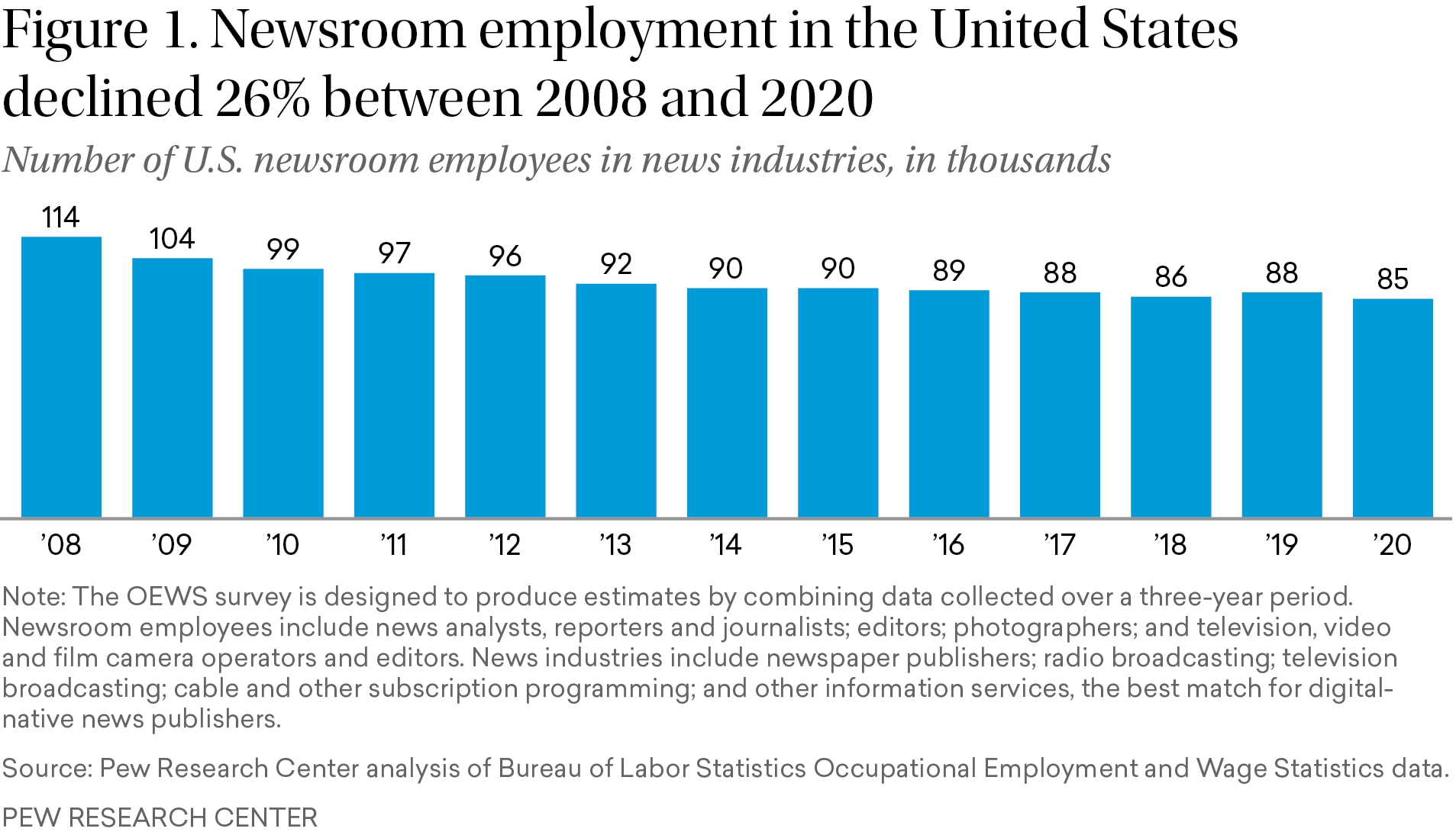
Beyond those fundamental economic forces that are hollowing out the news business, one of the striking things that we find is that there is now polarization in the level of trust the public has of national and local news organizations (see Figure 2). Democrats have maintained a relatively high level of confidence in national news organizations, but the decline of Republican confidence in national news organizations is striking. Local news organizations haven’t seen quite the same dramatic results. Coincidentally, social media and tech companies more generally have also experienced some of this polarization in trust.
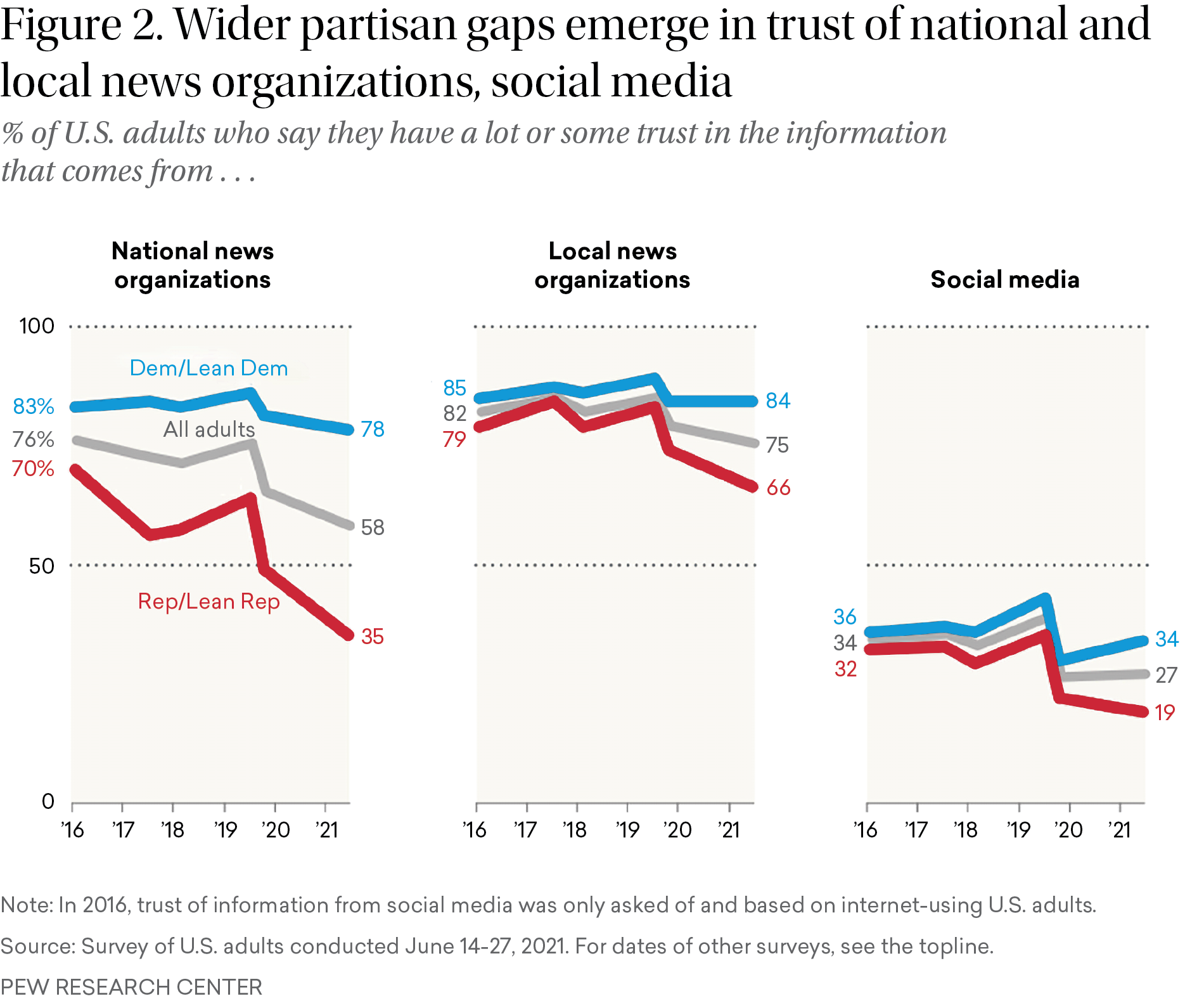
A consequence of this is that there has been a partisan sorting of audiences among news publications and news operations. In Figure 3, we see the levels of trust for some of the most important and largest news organizations. What the data show is that the liberal audiences of some news organizations are greatly at variance with the conservative audiences of other news organizations. The declining trust in news organizations is really a story about how people are migrating to different kinds of sources for different kinds of purposes, particularly partisan purposes, when it comes to large-scale news organizations.
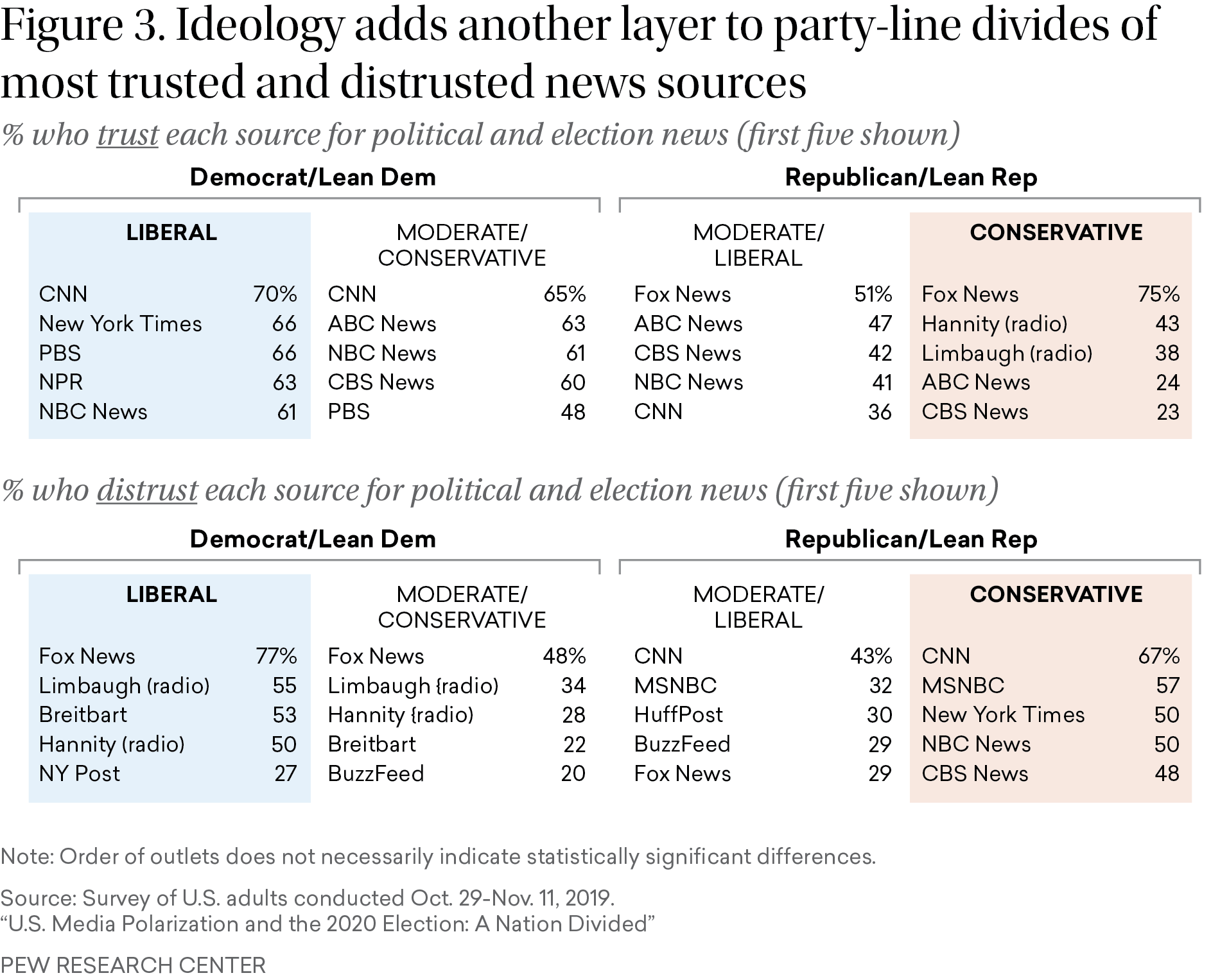
For social media, it is not a one-size-fits-all phenomenon (see Figure 4). Different platforms serve different purposes. Social media, as a whole, is not necessarily trusted to deliver the kind of civic and news information that people need. People customize the filters for their social media feeds; they organize their news feeds to privilege certain kinds of information; they structure their friendship groups to give them the information that they want. So, there are plenty of reasons why people still think that social media is a valuable news source at the personal level – giving them both relevant and relatively trustworthy information. But on the whole, the social media sphere has very low confidence among the broader public.
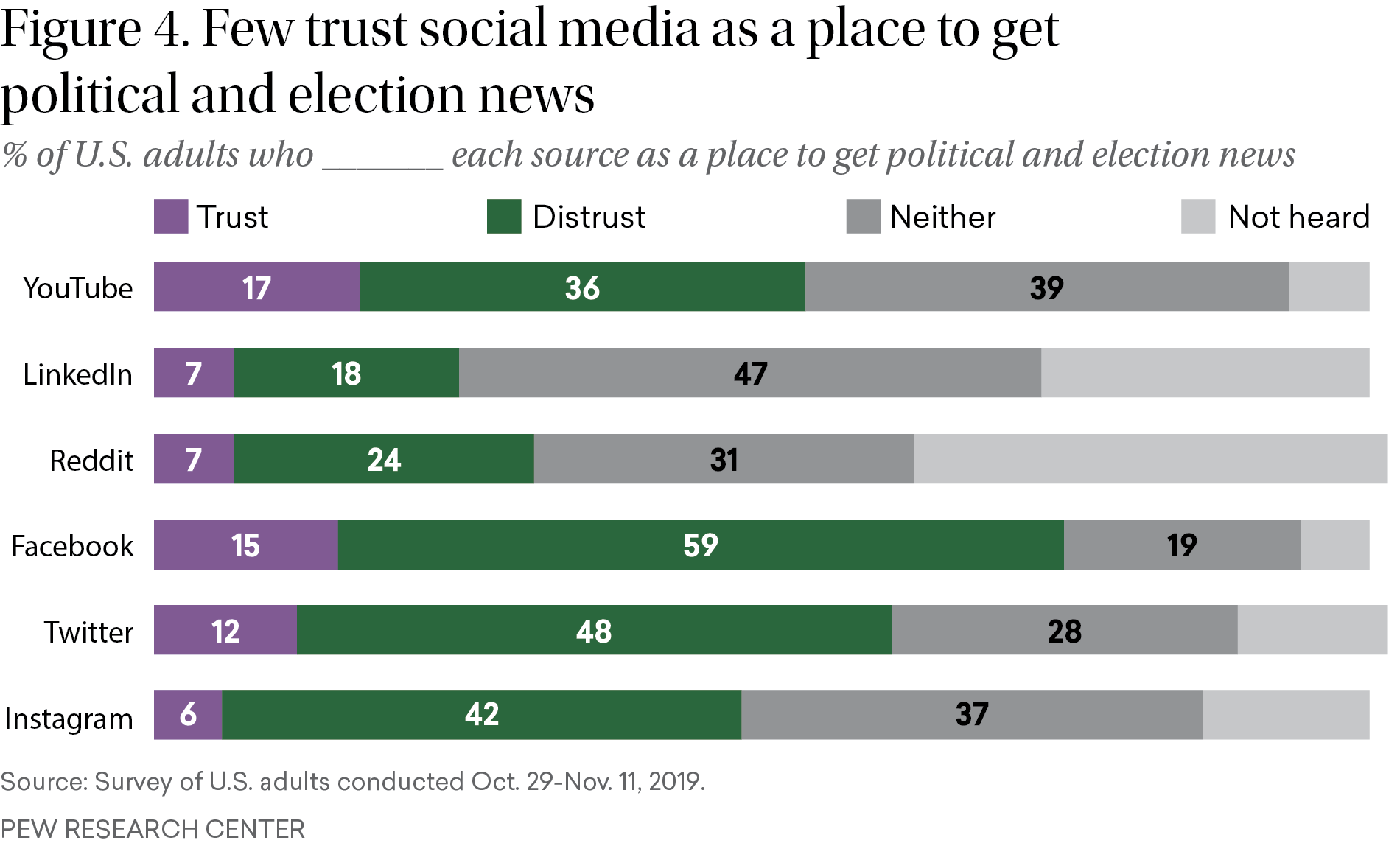
One of the core arguments I make in my Dædalus essay is that there are certain properties of digital media that have come into place that have changed media spaces and democratic discourse in ways that affect trust. These properties are things like digital information’s ability to be pervasive, portable, persistent, visible, personal, customizable, participatory, enabling creation, replicable, spreadable, scalable, and searchable.
A new organizing factor in social media is the algorithmic way in which certain kinds of information are elevated. In Figure 5, which is based on material that we gathered at the Pew Research Center from the social media posts of public officials, mainly members of Congress, we see that the more indignant the language is in a social media post by a member of Congress, the more likes, comments, and shares it gets. Those are the metrics that social media companies use to measure engagement, and they tweak their algorithms to deliver certain kinds of material to certain kinds of people based on those elements of engagement. There is a tremendous amount of concern about the ways in which social media algorithms radicalize the content that people are exposed to as they go down rabbit holes of recommended videos and posts. The result is that large majorities of Americans now believe that Republican and Democratic voters cannot agree on basic facts concerning important issues facing the country. When we measured this in the past, a majority of people said that partisans could agree on certain facts, even if they disagreed on policies. People no longer feel that’s the case.
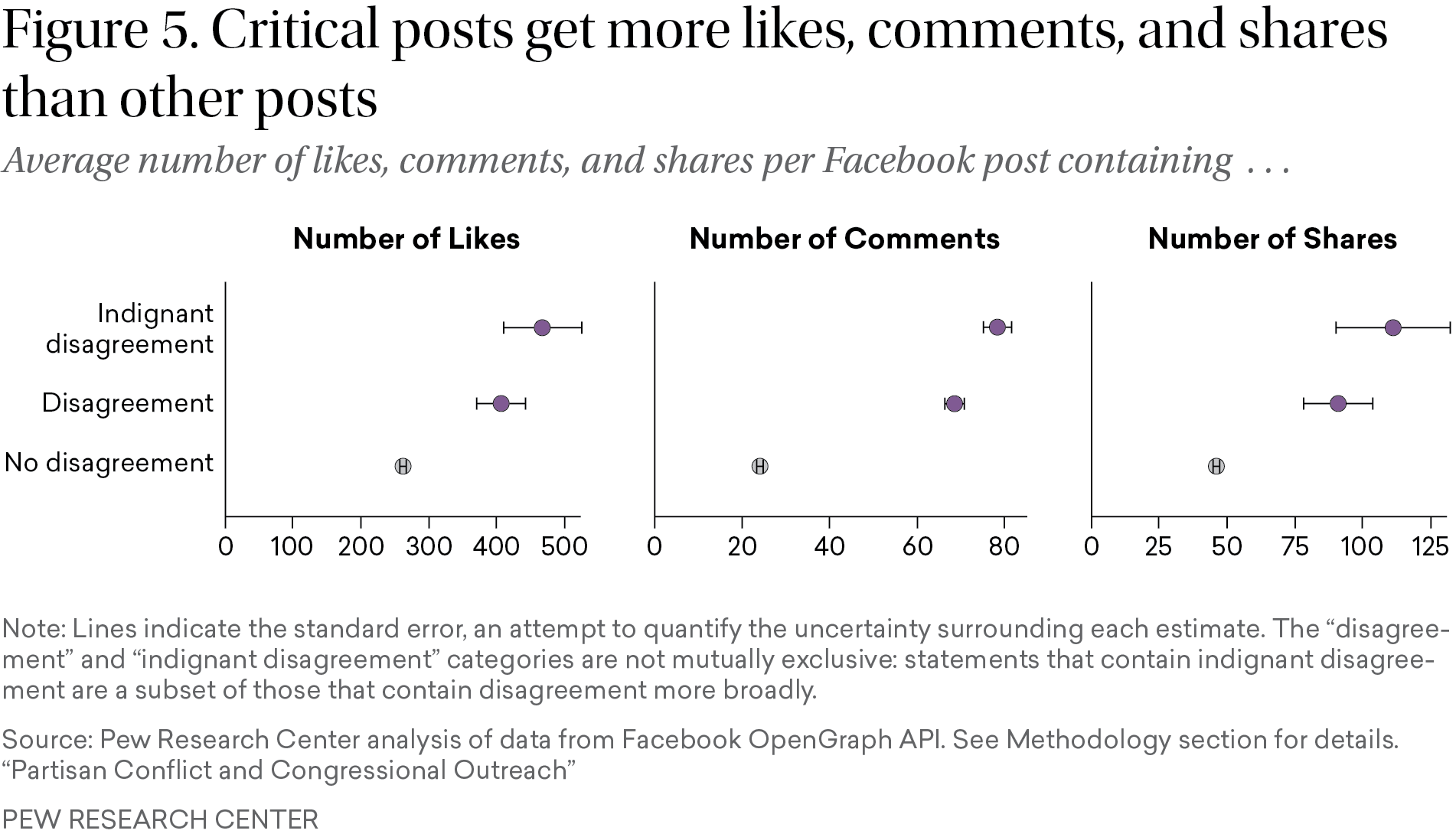
As Henry has pointed out, all of this is leading to lower confidence in all kinds of media. From a survey that Pew conducted between February 19 and March 4, 2019, we found that 68 percent of Americans have confidence in the government; 54 percent of Americans have confidence in each other; and 51 percent of Americans have confidence in the ability of political leaders to get the work done. As a result, Americans believe that public distrust of the government and people’s distrust of each other is getting in the way of the capacity of institutions to solve problems and address the major issues the nation faces (see Figure 6).
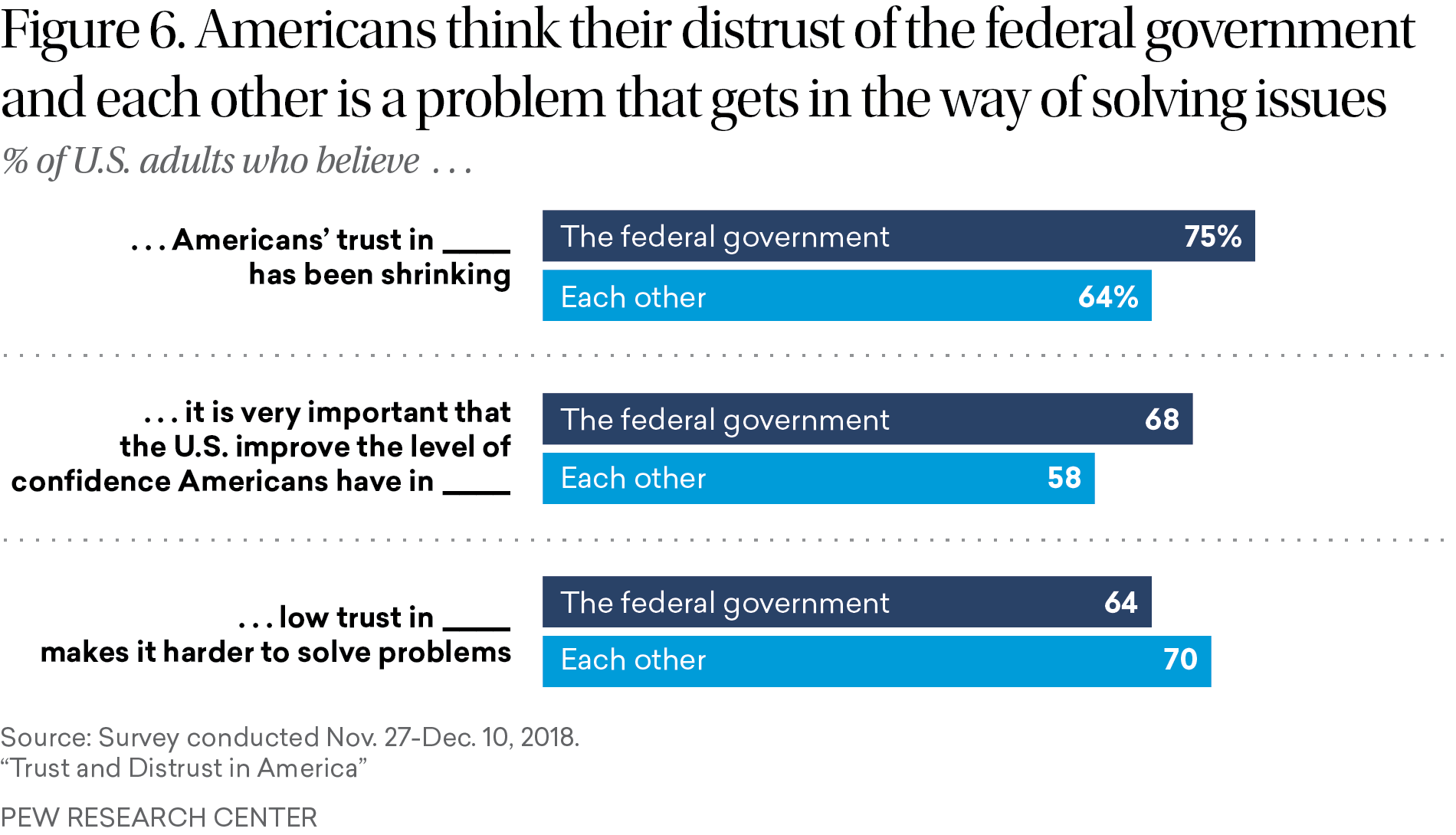
In my essay, I highlight a few reforms that are commonly offered: 1) an Internet Bill of Rights, which gives people control of their data and more power in their interactions with major tech platforms; 2) changes in social media algorithms to downplay anger and divisive discourse and offer sources that are accurate, present diverse perspectives, and encourage discourse and pathways to agreement; 3) embrace of radical transparency in both formal news operations and social media; 4) reviving journalism and creating public spaces, like public broadcasting in TV and radio; and 5) creating new educational programs for digital and civic literacy.
Kay Lehman Schlozman
Kay Lehman Schlozman, a Fellow of the American Academy since 2003, is the J. Joseph Moakley Endowed Professor of Political Science at Boston College.
Thank you, Henry, Tracey, and Lee for your presentations. You have convinced me – though I really didn’t need any convincing – that trust is an important phenomenon if our institutions, our society, and our government are to work well. But for us to trust institutions, they need to be trustworthy. Let me start our conversation by posing a question to all of you: if you could make a change in the institution that you were talking about that would make it more trustworthy, what would you do? Lee, let’s start with you.
LEE RAINIE: There are ways now in which trust is a contingent kind of social exchange between people. People are not making big, binary judgments about whether they trust an institution or not; it is more transactional and in the moment. For journalism, we can follow the playbook that Kay, Henry, and Sidney Verba gave us about the public’s voice itself. The most interesting experiments that have tried to test how journalism can become more trustworthy relate to how it can become fairer, particularly to the voices that are not often heard in our culture. And how it can be oriented toward a type of social criticism that is more constructive. So, giving voice to the populations that don’t necessarily have a voice in political institutions is one change that many advocate. The other thing that a lot of people talk about is changing the narrative style of journalism itself: having it be less “bothsidesism” and having it focus more on the central context and the truthfulness of facts.
KAY LEHMAN SCHLOZMAN: Tracey, what would you change for the police?
TRACEY L. MEARES: I mentioned a few things in my presentation, but let me emphasize one, which is for policing to take seriously the concept of trust itself. This was the work that I did with Tom Tyler, and it is in the President’s Task Force on 21st Century Policing: the idea that the job of the police is to think about encouraging a more trusting relationship between police as servants of the communities, rather than as warriors against crime. What does that mean? Once you make trust central, you understand that the job itself needs to be fundamentally different. That it’s difficult to take armed emergency responders who are deployed for a range of problems in primarily disadvantaged communities and think that is going to fundamentally change that trusting relationship. It is not. It is why people are talking about reducing the footprint of armed emergency responders. I think the task is to think differently about how the state is helping communities promote safety. That doesn’t mean that the state should not be involved at all – in fact, I think it is critical that they are. Citizens deserve state support for their safety. But it does mean that the idea that we are going to address these problems by sending people with guns to every single problem is just a fundamentally bad one.
SCHLOZMAN: Henry, would you like to respond to anything Tracey or Lee said, or mention another institution that you have considered in your global examination of this issue?
HENRY E. BRADY: The literature says there are four ways to create trust in institutions. One is for a governmental entity to bestow its regulatory legitimacy on other institutions. It is not clear that is a very good strategy these days, because government has its own trust problems. A second way is for cultural norms to be respected by institutions, but perceived lack of respect is part of what we face right now. Some people think that institutions are not acknowledging the cultural norms that should be recognized. And this connects to trust in the police. A third way is to be ethical and adhere to the normative standards of society. Many institutions fail in this, with scandals and other sorts of corruption. And the fourth one is for institutions to perform efficiently and effectively. To me, this last strategy can appeal to all political partisans, so that it may be most capable of restoring trust. But it does require government and these institutions to work better than they have in the past. Speaking as a former dean of a public policy school, that is where we need to put a lot of effort.
SCHLOZMAN: Since institutional performance is imperfect – and Henry just elaborated on that – institutions need to be accountable, which of course implies that sometimes naive trust may have its own dangers. What is the sweet spot on the continuum between skepticism and trust that works well? Lee, would you like to go first?
RAINIE: Being factual is the starting place. If you want to organize for the distribution of public goods, the starting place is the presumption that trust is generated from truth. Until recently that was the widely held view, but it is slipping in some segments of the population. The problem most Americans see now is that true institutional accountability is lacking. The tactic that is driving against that comes from those entities that Naomi Oreskes calls the “merchants of doubt.” The forces against which trust-builders are fighting seem more organized and more potent than they might have been in the past. Robert Proctor, a historian of science at Stanford, talks about “agnotology” as a well-practiced science. It’s the science of creating doubt about institutions. And it runs strong in our current political climate.
SCHLOZMAN: Tracey, would you like to add anything?
MEARES: I have to admit that I have some trouble getting my head around the concept of a sweet spot, given the kinds of things that I study and how I think a commitment to process-based legitimation might help improve trust in policing. What I can say is that the idea implies something that is more transactional and focused on back-end accountability: you trust police to do certain things, and then they harm you. We have seen too many instances of this on social media. Instances of police doing horrific things but also just being less civil and less polite. Jennifer Eberhardt at Stanford has wonderful research showing that it is not so much that police are ruder to Black people as opposed to white people; they are simply less polite. I just read a paper by Nicholas Camp that shows you can identify this in the tone of how police speak to people. Maybe one way of understanding this sweet spot is to think about accountability differently. Another colleague of mine, Barry Friedman, and his coauthor Maria Ponomarenko write about the difference between front-end accountability and back-end accountability. When we think about police access, we think about holding particular police officers or particular agencies accountable for wrongful things they have done. This is certainly important. But what is also critical in the process of reform transformation change is to imagine different institutions for articulating the goals and projects of what police or state actors devoted to safety do. There are very few mechanisms that take that seriously. I explore a couple in my essay, but we need much more. Not so much civilian review boards, which is a kind of after-the-fact review of what individual police officers do, but civilian policy boards that channel what communities what these agents to do for them.
SCHLOZMAN: Henry, would you like to comment?
BRADY: In the Dædalus volume, there is a wonderful essay on trust in the military. In the data that I showed, the military is the one institution in which trust has increased, and the authors ask if that is a good or bad thing. Should we be somewhat skeptical of the military? In fact, it is challenging to know exactly what the sweet spot is for trust. But our current problems go beyond distrust. It is clear that we have polarization in trust and a tremendous disagreement in society about which institutions to trust and which institutions not to trust. And that makes it very hard for those institutions to work. Take the police, for example. Some say, “We should spend a lot more money on the model that we have used historically, because it has worked so well.” And the people who distrust the police say, “No, it really hasn’t worked well at all.” That is one of the fundamental problems we face, regardless of how we feel about the sweet spot for trust.
MEARES: This might just be another way of saying that different groups of people want these institutions to do different things.
BRADY: But they need to square that circle, because those institutions are responsible for serving everybody, and they have to figure out a way to do that. I think your notion of trying to focus more on procedural justice and on trust instead of just how many people we have put in jail is a very good one.
SCHLOZMAN: Let me ask one last question before we turn to the audience’s questions. Students of Congress sometimes talk about Fenno’s paradox, the fact that many people disapprove of Congress, but love their own member of Congress. Similarly, Americans are skeptical about American medicine, in general, but are enthusiastic about their doctors. Is there an analog to Fenno’s paradox in your realm, Tracey, and in your realm, Lee?
MEARES: There are lots of stories in which the relationship between police and the members of the neighborhoods that they are policing is considered to be poor at best. Yet many people in those communities can tell you about the one police officer whom they like or even love. My guess is that this may not be the same kind of phenomenon that you are talking about with respect to a congressperson. It is perhaps more like my neighbor is a good cop and all the other cops are corrupt.
SCHLOZMAN: Lee?
RAINIE: The press version of this is closer to Fenno’s original idea. Americans can articulate very well which local news personalities and which columnists they like, but the broad institution is what they judge and what they say they don’t trust. The other thing that the modern era has taught us is familiarity breeds empathy. The more we know about each other’s lives and the more we have a sense that the person on the other end of the screen or the other end of the stethoscope is on our side, the more willing we are to invest our trust in them.
SCHLOZMAN: Let’s hear now from our audience. One question that several audience members have raised is which democracies might we compare ourselves to, and how do they cultivate trust? Are other rich democracies facing the same issues about trust that the United States is facing? Henry, would you like to start?
BRADY: Other countries are facing similar kinds of problems. There is no question that there have been declines in trust in other nations and also some polarization in trust. And it seems to be linked with a rise of populism and more authoritarian impulses. I don’t know that much about how other nations are trying to increase trust in their institutions, but I will say that one thing that works in America is when institutions are close to the people. National institutions are typically less trusted than state institutions, which are less trusted than local institutions. And that gets back to Lee’s comment about localism. Part of what we need to do is to think about policies that we make globally but implement locally. We need to figure out ways to put a face on the institution so that people will trust it.
MEARES: Though my research doesn’t really focus on levels of trust in other countries, what I can say is that the concept of procedural justice tied to legitimacy is robust outside of the United States, and has been studied all over the world. It is not surprising that the research is spotty in China. In terms of what people have tried, I have done work with the police force in Birmingham, England. They have made a really concerted effort not only to think about how officers treat people in the street, but even more important, about the implications for this approach for how the institution is organized. It is difficult for officers to treat people on the street with procedural justice when their own managers and supervisors don’t treat them that way.
RAINIE: Many residents, both in developed and developing nations, think social media is a net good for society. They like the empowerment that it provides to people, they like that it is side-stepping around institutions that don’t give them a chance to promote their voice and don’t let them tell the stories that they want to tell. The other thing is that people around the world are quite confident in their own capacity to make judgments about the things that they believe are trustworthy and are worth paying attention to. But they also think that their societies at large are struggling with these issues. So, it is a sort of “I’m okay, everybody else is screwed up” kind of dynamic. And it speaks to the problems that Tracey was alluding to of how you build trust in an environment where people think they can navigate the ecosystem relatively well, but everyone else is incapable of navigating the mess.
SCHLOZMAN: We have a question for Lee. How does reality television feed into some of the things that you have been talking about?
RAINIE: It is a companion phenomenon – sort of the bread and circuses offering of the twenty-first century. Henry mentioned appropriately that inequality is one of the other factors that is driving a lot of this distrust beyond polarization. People are less in control of their lives, they are less in control of their data, they are less in control of the way that they are being steered and profiled. There is a strong sense that people are struggling to make meaning out of a world where they don’t have a sense of what is going on behind the curtain in their lives. Reality television gives them an outlet to forget their troubles and often laugh at others.
SCHLOZMAN: We have a question for Henry. Are people really answering surveys these days and can we trust the longitudinal data that show changes?
BRADY: I think we can trust the data. I believe that given the nature of these polls and the crosschecks that we have, I’m pretty sure that they are measuring something real and that we can be confident in them. One of the problems that we face is that we don’t know if we have a good representative sample of Americans on the web. And the web is where more and more people now are doing most of their work and interacting. Telephone surveys don’t work the way they once did, and in-person surveys are ridiculously expensive. So, we just don’t have some of the controls that we have had in the past, but I believe that we have found ways, typically through weighting the data using information about the makeup of the population, to ensure that surveys provide representative results. By the way, I also see that somebody has asked a question about whether the Defense Authorization Act should be considered here, which has some things in it about trying to create a program for civic education. I think that is a good idea if the education emphasizes the importance of people collaborating and compromising with each other to solve problems. Civics education in America is focused too much on what is in the Constitution, what are the laws, and not enough on teaching people that when you have a problem, everybody needs to be in a room together and there must be compromise. One of the problems we face in America today – and we saw it recently with the choice of the Speaker for the House of Representatives – is that there are people who simply think compromise is a dirty word. And if that is where we are, then it is going to be hard to get anything done.
SCHLOZMAN: A question for Tracey. How do schools, particularly middle schools, fit into trust in police or lack of trust in police?
MEARES: I have a few answers. First, legal socialization is important to the ideas about procedural justice that I spoke about earlier. In fact, what Henry was talking about, the mechanisms that we use to teach kids how to solve problems, is related to these ideas of processed-based legitimation, especially when you think about the fact that a child’s teacher is the first authority figure whom the child interacts with outside of her parents. There is fascinating research by a psychologist named Rick Trinkner that shows a relationship between parenting styles, a child’s relationship with teachers, and a child’s relationship with police officers. I don’t do developmental psychology, so I can’t say much about what is going on in middle schools. My research center, The Justice Collaboratory, has done some work on the relationship that high schoolers have with school research officers. Tom Tyler and colleagues are doing that work. I think it is important to think about the idea of legal socialization in a broader way than just schooling. Ben Justice and I have a paper in the Annals of the American Academy of Political and Social Science titled “How the Criminal Justice System Educates Citizens.” Outside of public schools, the criminal justice system is one of the primary mechanisms by which people learn about their status and identity as citizens. We explore that idea in our essay.
SCHLOZMAN: We have a question for Henry, which I’m going to read verbatim. “Henry, your findings that distrust appears to have spread from specifically political to social and economic institutions are apparently related to polarization. Does this mean that our whole society has become increasingly politicized? And might it be possible to depoliticize reactions to social and economic institutions as part of the solution?”
BRADY: I think what it means is that we have more politicization of institutions that were not politicized in the past. And that is a worry. It may be a sign that we are finally confronting some problems, so it is not necessarily all bad. But institutions have to be responsible for thinking about how they create trust in the communities that they serve. And that is their first and foremost job.
RAINIE: The actors in the system who want to politicize things are truly adept at finding ways to bring these culture war kinds of things into institutions where they hadn’t happened before. Local school boards are a good example. They are now becoming battlegrounds. And higher education is another. We have Pew data from a couple of years ago that show that Republican confidence in colleges and universities has plummeted, and this is from a survey that asked about these institutions’ impacts on society. So, Henry is right; all kinds of institutions now need strategies for maintaining or restoring trust. They have to fight, though, against the forces that are pushing in the other direction. There are so many provocateurs in the system.
SCHLOZMAN: I would like to follow-up on your comment, Lee. To what extent does the fact that the media are paid to cover that which is newsworthy play a role in this?
RAINIE: Americans are in distress about that, too. No matter where they sit on the partisan spectrum, they think there is too much sensationalism and too much commercialization of storytelling. But at the local level, particularly, people with different perspectives are finding ways to solve problems and are becoming models for state and national politics.
MEARES: But we are losing our local newspapers. I was so distressed a couple of years ago about the state of national media that I stopped reading The New York Times daily and I started reading the New Haven Independent, which is a wonderful online local paper with detailed stories about what is going on in my city and the kind of problem-solving you mentioned. I think too many people don’t have access to high quality local news and newspapers.
SCHLOZMAN: Our next question may call for some speculation. Much of what we have been talking about has focused on political parties and polarization. But what about the trajectory of trust in parties or the extent to which trust in parties is an important element of democratic institutions?
RAINIE: This is the age of do-it-yourself identity formation. People are cobbling together partisan belief systems, moral belief systems, and spiritual belief systems, and it is a smorgasbord.
SCHLOZMAN: I am going to read the next question. “What, if anything, can nonpolitical institutions – and Henry talked about nonpolitical institutions as opposed to governing ones – do to regain the confidence of people who see them as pursuing distasteful political goals? For example, should journalists or professors change the way they do business in the hopes of mollifying conservative critics?”
BRADY: At Berkeley, we are very clear that we are an important American public institution and that we have to behave in ways that model correct behavior. We therefore have worked hard to protect free speech. That is why somebody like Milo Yiannopoulos was able to have an event at Berkeley, which very few people showed up for. Nevertheless, the right-wing media blamed Berkeley for the poor attendance, saying it was the school’s failure, when it wasn’t at all. It was a failure of Milo Yiannopoulos. So, part of the problem is that we have provocateurs. Lee refers to this at the end of his essay. We are in a period similar to when Gutenberg first invented printing and when, right after the French Revolution, everything seemed up for grabs in terms of the media, culture, and society. We will need to work hard to find a new equilibrium. Maybe it is worth reading about those periods to see what happened when suddenly everybody could print a book with all sorts of nonsense in it or perhaps wisdom in it, but it was sometimes hard to tell the difference. In time, editorial boards were created for presses and for newspapers to ensure that wisdom predominates over nonsense. We see the problem most clearly with respect to the internet, where we still do not have the mechanisms that we need to make sure that people understand what is nonsense and what is not.
MEARES: Let me offer my own opinion, although this is not my research. The idea that I would change how I do my job, when my approach is to make sure that my students understand concepts and facts, is not something that I am going to do. What it does make me think about, however, is how do we get back to a world where people can agree on a certain set of facts and then disagree on policies. The business model underlying mainstream media is critical. It is difficult to commit to a deep understanding of facts when your business model is devoted to chasing clicks.
RAINIE: There are a couple of essays in the Dædalus issue that do a marvelous job at looking at science and trust in science. They almost uniformly make the point that engagement has to occur. For a long time, scientists thought that public engagement was too messy or too removed from the role of gathering and organizing the evidence. I think there is a powerful argument in some of the essays that engagement by experts is the starting point on this. And those who push for this argue it should be engagement with humility. Ordinary people have their own stories, their own experiences, their own ways of understanding things. Yelling at them about what is a fact and what is not, what is to be believed and what is not, did not work during the COVID-19 pandemic. It did not close the deal with people who had skeptical points of view.
SCHLOZMAN: We have time for one final question. How do the unprecedented developments of the last few years affect the issues that we have been talking about today?
RAINIE: I think these developments have fundamentally changed the way people approach information and evidence about the society around them. People are covering themselves in partisan wrappers. But there are a lot of liberals who listen to conservative talk radio, and there are a lot of conservatives who watch liberal media. They don’t do it to get a separate point of view. They do it to figure out what the enemy is up to.
MEARES: The problems that we need to solve are more difficult to solve than they have ever been. And the approach that I have thought about takes a page from something that Henry said earlier, which is you need to be very local. It is harder to make arguments about national level interventions in policing than it is in schooling and education. I think there is a way in which that can be a strength for this approach, given the comments and conversations we have had about the way trust is built from the bottom up and locally.
BRADY: I think it is important to remember that the trends that we show with the data that we have are fifty years in the making. As Lee’s data show, the business model that focuses on indignation and being angry is one that has created division among us, and we have to find ways to get beyond that. I think the problems we face require very fundamental thinking about how we reinvigorate democracy. I will give a plug here for an American Academy study that produced the Our Common Purpose report, which has a lot of great ideas about how to think about making things better. One of the things they focus on is reinvigorating local media. We need our local newspapers because without anyone watching, corruption is going to increase in local government. Let me give you one example. In Bell, California, there was a scandal involving the misappropriation of public funds by people who were unwatched. So, we need local media, and we need it badly. And we need a model that supports local media because their revenue sources – advertising and so forth – have been taken away. We need to support local media so they can report on the content that is vitally important to our ecosystem.
SCHLOZMAN: Thank you, Lee, Tracey, and Henry for today’s wonderful conversation. I leave the final word to David Oxtoby.
OXTOBY: I hope everyone has enjoyed this discussion as much as I have. Let me thank Henry and Kay for their leadership of this Dædalus volume, Tracey and Lee for their contributions to the volume, all our speakers for their very thoughtful comments, and our audience for joining us today. The Dædalus issue on “Institutions, Experts, and the Loss of Trust” is available open access, along with decades of volumes, on the Academy’s website. I hope you will continue to engage with this work and share the essays with colleagues, friends, and students. This concludes the 2110th Stated Meeting of the American Academy.
© 2023 by Henry E. Brady, Tracey L. Meares, Lee Rainie, and Kay Lehman Schlozman, respectively
To view or listen to the presentations, visit the Academy’s website.
